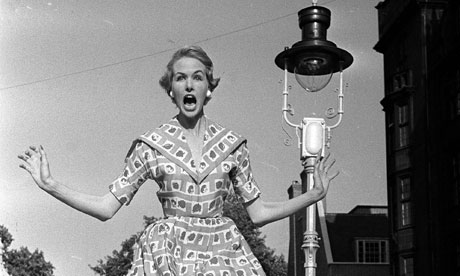When, in her 70s, Jennifer Hocking swanned through a 2002 Burberry advertising campaign shot by Mario Testino, sharing photospace with Kate Moss and company, and trumping them for cool, the New York Times called her a "grande dame of modelling". As a teenager, she had worn the first Dior "new look" styles to reach her native Australia. It amused her to show her 21st-century counterparts how to fill a black-and-white page with old-style choreography of wrist and elbow. Hocking has died aged 81 of cancer.
Born in Sydney, she went to art school, modelled and acted a little, then in 1952 sailed for Britain, borrowing the fare from her brother, after a fortune-teller twice predicted her successful future in London. There she met and married an actor and model, Nigel Howland, although hers was the more sustained career, at its most successful in the transitional era of the early 1960s, when there was a demand among upstart, unposh photographers for models who could project sophistication with a twist, drink and cigarette in hand.
The models supplied their own smokes, and were not ladies as their predecessors had been. Hocking looked like what she was, a grown woman with a job, perhaps a resourceful PA, when Brian Duffy posed her beside the novelist Frank Norman. Helmut Newton liked her, and along with the stylishly similar Paulene Stone, she was a reliable favourite of Terence Donovan and David Montgomery.
By the mid-60s, though, she realised that she was registering on camera not as too old, more as too adult, as teen models, freer with their knees than their elbows, began to dominate the business. She took a stylist's job – just an extension of models' obligations to provide their own accessories and do their own makeup – on a Fleetway magazine, simply called Fashion, and when that soon folded, was passed to the relaunched Harper's Bazaar as fashion editor, succeeding Molly Parkin. Hocking was in situ when Harper's merged in 1970 with its failing rival, Queen magazine, as Harper's & Queen.
Technically, that put her in charge of the gloss on the UK's second-shiniest magazine, although its fashion department was tiny. Despite increased pagination as H&Q began to invent modern luxury advertising, she had only a limited budget, and so when recruiting editorial assistants, merely looked for competent help.
She hired a well-connected, inexperienced 21-year-old, the "driven, determined and ambitious ... and very together" – Hocking's words – Anna Wintour, who impressed Hocking by lunching with business contacts rather than on a junior's usual sandwich at the desk. "She had this incredible brain, and I used to think it would be amazing to meet her when she was 35, because she was too mature for her age." She forgave Wintour her lack of a gift with words (Hocking never could spell, was always surer with an image than a paragraph) and encouraged her dedication.
Hocking was for much of the decade on the informal "committee" that adjudicated British fashion in the 1970s. She chose Missoni knits as her 1974 dress of the year for Bath Museum of Costume, making a shrewd, very long, bet on the Missonis' continuing technical innovation and influence; she dressed Joanna Lumley's Purdey for a few episodes of The New Avengers (Lumley had been a fellow Duffy bird).
But the eccentric, improvised atmosphere of H&Q evaporated mid-decade as the magazine tried to challenge Vogue for supremacy, and Hocking chose to leave. Wintour campaigned for the job, but it went to Min Hogg, while Hocking designed first for the mail-order clothes company of Christopher Carr Jones, then ran her own such company.
She began to model again in the 90s, at first for the older woman, Good Housekeeping, market – racehorse legs, white hair that could be back-combed into meringue, plus the old attitude. Testino had a crush on early-60s Englishness, the use of monochrome, the stress on relationships between models, and that was where he took his Burberry shoots, calling back as dress extras the elegant women who had bowed out circa 1966, including Tania Mallet and Hocking.
He understood that their body language, added to his rom-coms of crazy rich kids, could help to reposition the brand back among the toffs. Hocking, loving clothes, was always invigorated by the shoots. Her main complaint about the illness that blighted her last year was that it meant she had to give up wearing jeans, and so it "robbed me of my youth".
Her marriage ended in divorce. Her daughter, Wendy (who began as a model by sharing her mother's working wardrobe), and her son, Julian, survive her.
• Jennifer Hocking, model and fashion editor, born 4 October 1929; died 27 May 2011


No comments:
Post a Comment